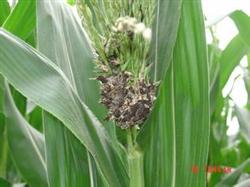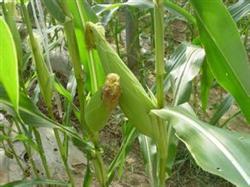Sowing techniques for High yield of Spring Maize

In order to improve the sowing quality of spring sowing corn in Hetao irrigation area, seed selection, fine soil preparation and timely sowing should be done actively, which is very important to protect the whole seedling and harvest of spring sowing corn. 1. Select the good varieties suitable for the right way: according to the heat resources and the actual irrigation area, the middle and late maturing varieties with a growth period of 120-130 days should be selected. Through the investigation of planting varieties in Bayannur city in recent years, the main maize varieties with outstanding comprehensive characters are Badan 3, Kehe 8, Neidan 314, Badan 25 and so on. Second, apply sufficient base fertilizer: spring corn should grasp the principle of applying more base fertilizer because of its long growth period, and organic fertilizer should be applied early, combined with soil preparation, generally applying 2000 kg of organic fertilizer per mu. Nitrogen, phosphorus and potassium fertilizer can be used as seed fertilizer at one time during sowing, generally 25 kg of diammonium phosphate and 10 kg of potassium sulfate per mu. Third, improve the quality of sowing. Fine soil preparation: spring corn requires deep ploughing, and autumn ploughing as early as possible. Timely stubble ploughing after the previous crop harvest is beneficial to soil ripening, water storage and soil moisture conservation, and elimination of diseases, insects, weeds and so on. Rake and conserve soil moisture should be carried out in early spring. In places with serious spring drought, continuous operation of pressing, raking and harrowing is used to make the soil compacted and more conducive to soil moisture conservation. It can be sown directly where the soil moisture is good, and replenish the soil moisture to sow seeds where the soil moisture is insufficient. 2 selected seeds: when purchasing seeds, it is best to go to the entrusted units to buy high-quality and high-yield brand corn varieties that have been approved and tested locally, such as Badan 3, Kehe 8, Neidan 314, Badan 25 and so on. Fourth, sowing at the right time: early sowing of corn can easily lead to low-temperature rotten seeds and uneven emergence of seedlings, and too late sowing will lead to the normal maturity of grains in the later stage. Sowing can be carried out when the soil surface temperature is 5-10 cm deep and the soil temperature is 10 ℃-12 ℃. The suitable sowing time is generally from late April to early May. Fifth, reasonable close planting: increasing planting density is an important factor to achieve high yield of corn. The planting density of the plots with higher soil fertility is generally more than 4000 plants, and the suitable planting density of the plots with lower soil fertility is 3500 to 4000 plants per mu, and the sowing rate per mu is 22.5 kg. The planting method should be planted in large and small rows, and the sowing depth should be 4-6 cm. 6. Chemical weeding technology: chemical weeding not only saves time and effort, but also has a good effect, but we must choose safe and reliable corn field special herbicides and master its correct use method. There are generally two methods, one is to use chemical herbicides to seal the soil before seedling after sowing. The other is that the plots with poor soil closure treatment can be sprayed with corn special herbicides to kill weeds in the 3-5-leaf stage and 2-4-leaf stage. When spraying chemical herbicides, you should pay attention to using the medicine in the morning or evening when there is no wind and the relative humidity is more than 65%, and try to keep the sprinkler as low as possible so that the dosage is accurate, the amount of water is sufficient, and it is sprayed evenly, so as to avoid re-spraying and leakage spraying.
- Prev

Occurrence and Control of Black-streaked Dwarf Disease in Spring Maize
Black-streaked dwarf disease is a virus disease transmitted by gray planthopper, and the seedling stage is its main susceptible period. since the nineties of the 20th century, with the change of planting structure, the black-streaked dwarf disease of single-cropping rice and spring corn in Chun'an County has been aggravated year by year, especially since 2000. Rice black-streaked dwarf disease has generally occurred in the whole county.
- Next

Cultivation techniques of Spring Maize and late Rice
The main results are as follows: 1. The nursery seedlings are planted deeply, and the roots are promoted and the seedlings are protected by dry tube. The techniques of raising seedlings with fertile balls and floppy disks must be implemented, and the deep planting techniques of breast seedlings must be grasped. According to the study, the early-maturing and high-yield growth advantage of breast seedling transplanting is 6 days earlier than that of production and cultivation, with strong dry matter accumulation ability, strong plant, developed root system, large panicle and multi-grain weight, low empty culm rate.
Related
- The first cup of black tea in spring, the flavor and history of tea gardens in Kenya, Africa
- The computer can not only choose potatoes, but also grow tea rice. AI will grow winter oolong tea champion.
- It is not only the inflated tea bitten by insects, but also engraved with the four seasons tea in Beipu.
- The Oriental Beauty Tea Festival in Zhuxian County takes the stage at the weekend to experience the plus-size feast of oil tea.
- & quot; Oriental Beauty Tea & Exploration of Emei in Hsinchu, the hometown of quot;
- The new variety of strawberry "Tainong 1" dessert is the first choice with mellow aroma. Crimson gorgeous
- History of Tea in Taiwan: from Wild Inner Mountain to Export Tea Garden
- Two types of Taiwan Oriental Beauty Black Tea won the British three-Star Award for Childhood Tea Xiang Zhang Jiaqi changed from pilot to champion tea maker.
- Banana species and varieties: the planting history of Taiwan Xianren banana and dwarf banana is long, is banana disease resistant?
- Coffee planting Technology: Qianjie Coffee from Seedling to harvesting

